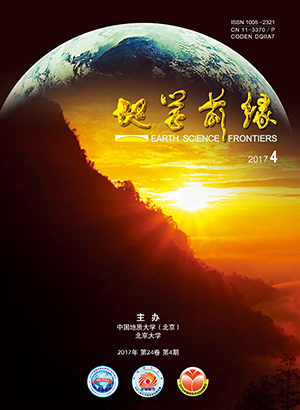|
|
The Yinachang deposit in central Yunnan Province, Southwest China: A “Bayan Obo-type” Fe-Cu-REE deposit.
WEN Ligang,ZENG Pusheng,ZHAN Xiuchun,FAN Chenzi,SUN Dongyang,WANG Guang,YUAN Jihai,FEI Xiaojie
2018, 25(6):
308-329.
DOI: 10.13745/j.esf.sf.2018.9.3
The Yinachang Fe-Cu-REE deposit is one of representative Proterozoic Fe-Cu-REE deposits in central Yunnan, SW China. Besides Fe and Cu, rare-earth elements (REEs, mainly La, Ce), Nb, Y, Mo and Co coexist in the deposit. Study has shown that REE contents are relatively high in both banded and vein ores ranging in (1446.8311259.23)×10-6 and (2020.923415.51)×10-6, respectively, with light REEs (e.g., La, Ce) especially enriched. Also, the content of rare element Nb reaches up to (278.8529.0)×10-6 in the banded ores. However, it has long been difficult to study mineral characteristics, especially occurrence characteristics, of rare and rare-earth minerals using traditional testing techniques, which were inadequate to identify these minerals due to complex mineral composition of ore deposit and relatively low mineral contents in ores. In this study, we used automated mineral identification and characterization system (AMICS)—the most up-to-date mineral automatic analysis system in mineralogy and geology in the world, combined with scanning electron microscope and X-ray energy dispersive spectrometer (SEM-EDS) microstructural in-situ analysis technique, to complete quantitative mineral identification in the Yinachang Fe-Cu-REE deposit, an undertaking unattainable by conventional means of rock-mineral identification. The results demonstrate that the deposit contains large quantities of parisites and bastnaesites and small quantities of monazites, allanites, columbites, fergusonites, yttrialites and Nb-bearing rutiles. Bastnaesites, monazites, columbite and fergusonite are mainly concentrated in the banded ores and closely associated with iron oxide minerals (magnetites), siderites, apatites, flourite and early sulfides such as chalcopyrite, pyrite, etc, while parisites, allanite, yttrialite and Nb-bearing rutile are enriched in vein ores coexisting mainly with chlorites, calcite, quartz and late sulfides such as chalcopyrite, pyrite, etc. Plainly, both iron oxide and copper sulfide mineralization stages are associated with REE mineralization. We identified two main mineralization stages, i.e., iron oxide-apatite-REE (Ⅱ-1) and Cu sulfides(-Au)-REE (Ⅱ-2) mineralization stages, both were apparently related to the deep (mantle) magmatic activities: bastnaesites, monazites, columbite and fergusonite primarily formed in the Ⅱ-1 stage, likely during the breakup of the Columbia supercontinent; and parisites, allanite, yttrialite and Nb-bearing rutile mainly formed in the Ⅱ-2 stage, possibly during the breakup of the Rodinia supercontinent. Through comparative studies, we found that the Yinachang Fe-Cu-REE and giant Bayan Obo Nb-Fe-REE deposits are comparable in tectonic settings, metallogenic element assembles, ore-hosting rock series, mineral compositions, ore-forming ages and material sources. Therefore, we propose, preliminarily, that the Yinachang Fe-Cu-REE deposit is a “Bayan Obo-type” deposit.
References |
Related Articles |
Metrics
|

